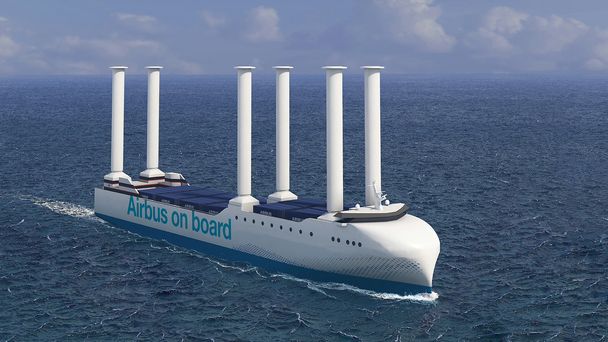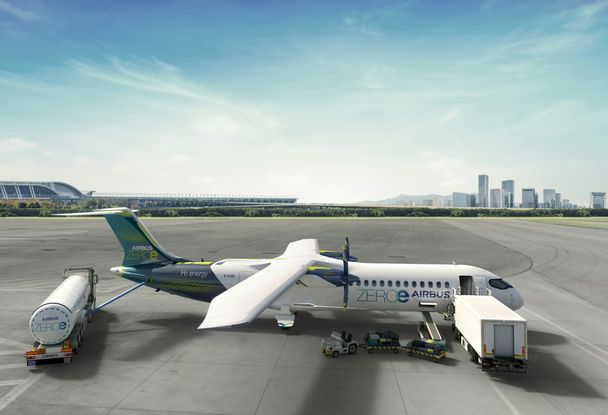Building a lower emission maritime transport fleet

Airbus’ transatlantic maritime fleet is getting an upgrade. From 2026, three specially-commissioned roll-on/roll-off vessels will carry aircraft assemblies between production facilities in Europe and the United States. Each will run on a mix of maritime diesel oil, e-methanol and wind-assisted propulsion.
Airbus’ purpose is to pioneer sustainable aerospace for a safe and united world. Reducing the environmental impact of its industrial setup is therefore a top objective, in line with its independently-validated scope 1 and 2 commitments. Accordingly the company is renewing its maritime fleet, which transports aircraft components between production sites.
The aim is to halve the company’s Atlantic fleet fuel burn and CO2 emissions by 2030 compared to a 2023 baseline, before securing even greater reductions during the following decade.
Dual fuel and wind power
It takes a multimodal transport network to feed a production system on which the sun never sets. Airbus has already introduced sustainable aviation fuel to its fleet of BelugaXL supertransporters, and its road operations use biogas wherever possible.
By air, by road…and by sea. Now Airbus will gradually renew the chartered vessels that ferry its aircraft subassemblies across the Atlantic between Saint-Nazaire, France, and its single-aisle aircraft final assembly line in Mobile, Alabama.
Airbus has commissioned Louis Dreyfus Armateurs to build, own and operate new, highly-efficient roll-on/roll-off cargo vessels that will enter service from 2026. Registered in France, each ship will be powered by a combination of six Flettner rotors and two dual-fuel engines. The engines will run on maritime diesel oil and e-methanol*. The percentage of the latter in the mix is expected to increase over time, leading to further emissions reduction.
*E-methanol is produced by combining green hydrogen and captured carbon dioxide.
Optimised routing
Flettner rotors - tall, rotating cylinders - generate lift at right angles to the wind, moving the ship forward. Routing software will also optimise the ships’ journey across the Atlantic, maximising wind propulsion and avoiding drag caused by adverse ocean conditions.
Today, three chartered vessels ply Airbus’ two maritime routes. On the Mediterranean, the Ciudad de Cadiz makes stops at Airbus and supplier production facilities in Tunis, Naples, Porto and Saint-Nazaire. The Ville de Bordeaux and City of Hamburg cross the Atlantic.
As the fleet is gradually renewed, the Ciudad de Cadiz will be retired from service. When the first of the new Atlantic vessels enters service in 2026, the City of Hamburg will transfer to the Mediterranean. When the second new vessel is delivered, the Ville de Bordeaux will move to the Mediterranean to replace the City of Hamburg. There, it will continue to operate with bound4blue’s emissions-reducing eSAIL®.
Extra capacity for ramp-up and other transport needs
Each new transatlantic vessel will have the capacity to transport around seventy 40-foot containers and six single-aisle aircraft subassembly sets - wings, fuselage, engine pylons, horizontal and vertical tail planes - compared to four today for the Ville de Bordeaux and three for the City of Hamburg.
Beyond supporting Airbus’ ambitious production ramp-up, the extra capacity could also be used to cater to the transport needs of other Airbus divisions or partners. It could also be harnessed to carry humanitarian aid on behalf of the Airbus Foundation.
By 2030, the new Atlantic fleet will generate 50% fewer CO2 emissions compared to 2023. The annual CO2 emissions per vessel on the transatlantic crossing are expected to decrease from 41,000 tonnes today for the Ville de Bordeaux and 27,000 tonnes for the City of Hamburg, to 11,000 tonnes by 2030 and as little as 5,000 tonnes each by 2040 for the three new ships. This major reduction would be achieved by increasing the percentage of e-methanol in the new vessels’ dual-fuel propulsion as more of the fuel becomes available.



